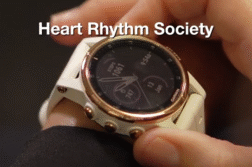SAN FRANCISCO, Calif. (Ivanhoe Newswire) – At just 17-months-old, one little boy has spent nearly half his life inside a hospital, diagnosed with a rare heart defect before he was even born. Discover how doctors were able to save him. Tetralogy of Fallot
Each year, only approximately 1,600 infants are diagnosed with tetralogy of Fallot. The rare condition is caused by a group of four heart defects, which impact blood flow in the body. The only treatment for this potentially fatal condition is surgery.
Seventeen-month-old Emmett Watanabe is getting bigger and stronger every day, and mom and dad couldn’t be more relieved.
“The fact that he babbles, rolls around like that, plays with toys,” says Emmett’s mom, Yatine Lee.
When Yatine was just 19 weeks pregnant with Emmett, he was diagnosed with tetralogy of Fallot, which is a rare condition involving a group of four heart defects.
Stanford Children’s Health pediatric cardiologist, Dr. Greg Adamson explains Emmett’s condition.
“There’s a large hole in the heart and then, there’s some amount of blockage of blood flow being able to get to the lungs.”
Emmett’s case quickly became exceptional. At 27 weeks, he was born by emergency C-section after the placenta began shutting down and his growth was stunted.
“He weighed only about 600 grams, which is about the size of a 14-ounce soda bottle. And at that point, his heart was only the size of a grape,” Dr. Adamson emphasizes.
In addition, his intestines had twisted and cut off their blood supply.
“It was a Saturday night at ten o’clock and we get called into the hospital,” Emmett’s mom, Yatine, recalls.
Doctors fixed one health crisis and then four days later, doctors placed a stent, less than a centimeter long, in Emmett to get blood to his lungs.
“We had never performed this procedure in a baby as small as Emmett,” Dr. Adamson mentions.
Two additional stents, and four months later, Emmett weighed seven pounds and was ready for open heart surgery and eight months after he was born, Emmett was ready to come home.
“Emmett is one of the biggest fighters I’ve ever seen,” Dr. Adamson says.
“To see where he is today, I think it’s pretty incredible,” Yatine exclaims.
Like many children with severe tetralogy of Fallot, Emmett will require two to three more surgeries until he stops growing. Doctors will operate to replace his conduit, which acts as a pulmonary valve, with a larger sized one. Otherwise, Emmett is a completely happy and healthy toddler and mom is crossing her fingers that he will become a cardiologist one day.
Contributors to this news report include: Jennifer Winters, Producer; Joe Alexander, Videographer; Roque Correa, Editor.
To receive a free weekly e-mail on medical breakthroughs from Ivanhoe, sign up at: http://www.ivanhoe.com/ftk
Source:
The Center for Disease Control and Prevention
MEDICAL BREAKTHROUGHS
RESEARCH SUMMARY
TOPIC: EMMETT’S JOURNEY: TREATMENT FOR TETRALOGY OF FALLOT
REPORT: MB #5064
BACKGROUND: Tetralogy of Fallot, or TOF, is a rare condition caused by a combination of four congenital heart congenital defects, or defects that are present at birth. The four heart defects include:
- Pulmonary valve stenosis (Narrowing of the lung valve)
- Ventricular septal defect (A hole between the bottom heart chambers)
- Aorta (Shifting of the body’s main artery)
- Right ventricular hypertrophy (Thickening of the right lower heart chamber)
These defects affect normal blood flow to the heart and the rest of the body. According to the CDC, about 1,660 babies in the United States are born with tetralogy of Fallot. Children with TOF are more likely to have chromosome disorders, such as Down syndrome, Alagille syndrome, and DiGeorge syndrome, which is a condition that causes heart defects, low calcium levels, and poor immune function. TOF occurs more frequently in males than in females and about ten percent of infants born with heart defects are diagnosed with tetralogy of Fallot.
(Sources: https://www.mayoclinic.org/diseases-conditions/tetralogy-of-fallot/symptoms-causes/syc-20353477, https://www.cdc.gov/ncbddd/heartdefects/tetralogyoffallot.html, https://medlineplus.gov/ency/article/001567.htm, https://rarediseases.org/rare-diseases/tetralogy-of-fallot/)
SYMPTOMS & DIAGNOSING: The symptoms of tetralogy of Fallot can vary. Depending on the amount of blood flow blocked, the symptoms may include: a bluish coloration of the skin caused by low blood oxygen levels, poor weight gain, tiring easily during play or exercise, irritability, prolonged crying, heart murmur, an abnormal, rounded shape of the nail bed in the fingers and toes, and sudden episodes of bluish skin during crying or feeding called tet spells. Tetralogy of Fallot is typically diagnosed during pregnancy or when a baby is an infant. However, depending on the severity of the defects and symptoms, the condition is sometimes not detected until adulthood.
(Sources: https://www.mayoclinic.org/diseases-conditions/tetralogy-of-fallot/symptoms-causes/syc-20353477)
TREATMENT & ONGOING CARE: The only treatment for tetralogy of Fallot is surgery soon after the baby is born. The most common is open-heart surgery, but a temporary procedure that uses a shunt may also be done. During open-heart surgery, doctors will widen or replace the pulmonary valve and enlarge the passage to the pulmonary artery, as well as place a patch over the ventricular septal defect to close the hole between the two lower chambers of the heart. These actions during surgery will improve blood flow to the lungs and the rest of the body and without them the baby may not grow and develop properly. Arrhythmias are a common problem after tetralogy of Fallot repair surgery, so doctors may prescribe medications. A leaky pulmonary valve may also become a problem for an adult with repaired tetralogy of Fallot and they may need to have their pulmonary valve eventually replaced. Infants typically live healthy lives after TOF surgery but will require regular follow-up visits with a cardiologist.
(Sources: https://www.mayoclinic.org/diseases-conditions/tetralogy-of-fallot/diagnosis-treatment/drc-20353482, https://www.cdc.gov/ncbddd/heartdefects/tetralogyoffallot.html)
FOR MORE INFORMATION ON THIS REPORT, PLEASE CONTACT:
Elizabeth Valente-Pigato
(650) 497-0827
evalentepigato@stanfordchildrens.org
If this story or any other Ivanhoe story has impacted your life or prompted you or someone you know to seek or change treatments, please let us know by contacting Marjorie Bekaert Thomas at mthomas@ivanhoe.com




